Perhaps the most fascinating film I saw at the 18½ Philadelphia Film Festival was Rembrandt’s J’accuse. It’s a documentary where British director Peter Greenaway deconstructs Rembrandt’s most famous painting: Night Watch. It’s arguably the 4th most celebrated painting in art history (preceded only by the Mona Lisa, The Last Supper, and the ceiling of the Sistine Chapel…) and Greenaway believes it’s also an accusation of murder. The movie plays like a forensic detective story as Greenaway analyzes the painting from top to bottom. It’s an interesting topic for a documentary, though I think the film ultimately falters a bit in it’s investigation (either that, or Greenaway is trying to do something completely different).
(Note, you can click on the images below for a higher resolution image.)
Night Watch
Greenaway began his career as a painter and he contends that most people are visually illiterate, which is an interesting point. We really do live in a text-based culture. Our education system encourages textual learning over visuals, from the alphabet to vocabulary and reading skills. The proportion of time spent “reading paintings as they do text” is minute (if it happens at all). As such, our ability to analyze visual art forms like paintings is ill-informed and impoverished. Greenaway even takes the opportunity to rag on the state of modern cinema (which is a whole other discussion, as sometimes even bad movies are visually well constructed, but I digress). In any case, I do think Greenaway has a point here. Our culture is awash in visual information – television, movies, photography, etc… – and yet, we spend very little time questioning the veracity of what we’re shown. They say that a picture is worth a thousand words, which is really just a way of saying that pictures can easily convey massive amounts of information. Pictures are inherently trustworthy and persuasive, but this can, in itself, cause issues. Malcolm Gladwell examined this in his essay, The Picture Problem:
You can build a high-tech camera, capable of taking pictures in the middle of the night, in other words, but the system works only if the camera is pointed in the right place, and even then the pictures are not self-explanatory. They need to be interpreted, and the human task of interpretation is often a bigger obstacle than the technical task of picture-taking. … pictures promise to clarify but often confuse. … Is it possible that we place too much faith in pictures?
Gladwell is, of course, casting suspicion on images, but he’s actually making many of the same points as Greenaway. What Gladwell is really saying is that human beings are visually illiterate. As Greenaway notes towards the beginning of the film, is what we see really what we see? Or do we only see what we want to see? Both Gladwell and Greenaway seem to agree that interpretation is key (though Gladwell might be a bit more pessimistic about the feasibility of doing so). Though this concept is not explicitly referenced later in the film, I do believe it is essential to understanding the film.
One of the first clues that Greenaway examines is the public nature of Rembrandt’s painting. For the most part, public museums didn’t start appearing until the mid 19th century. The Night Watch, by contrast, was on public display from day one (1642). In a time where paintings were private luxuries, usually viewed only by the rich and those who commissioned the paintings, the Night Watch was viewed by all. In a lot of ways, the painting is unusual and prompts questions, most of which don’t seem to have any sort of satisfactory answers. This leads to all sorts of speculation and theories about the motives behind the painting and what it really depicts. One way to look at it is to view it as an accusation. An indictment of conspiracy. Greenaway starts with this idea and proceeds to examine 34 interconnected mysteries about the painting. The mysteries all server to illuminate one thing: The content of the painting. What is it about? Who are the players? What is the accusation?
I will not go through all 34 mysteries, but as an example, the first mystery is about the Dutch Militia. At the time of the painting, there was a century-long Dutch tradition of the group military portrait. The Dutch had been involved in a long, drawn-out guerrilla war with the Spanish. Local militias were formed all throughout the country to protect their towns from their enemies. These local companies were comprised of regular citizens and volunteers, many of them important local figures, and they liked to have themselves painted, usually in uniform and in a powerful light to inspire solidarity and confidence. As the war wound down, these militias became less about the military and more about politics and power. It was a prestigious thing to be in a militia and they became more of a gentleman’s club than a military organization. In the Night Watch, Rembrandt chose to break many of the traditions associated with the common Dutch military portrait. Many of the future mysteries examine these differences in great detail.
After seeing the movie I was struck by numerous things. First, for a filmmaker ostensibly crusading against visual illiteracy, I find it strange that Greenaway has chosen to present his argument as a gigantic wall of text. He narrates the entire film. Occasionally, he’ll cut to a “reenactment”, which are scenes from his previous film, a fictional retelling of Rembrandt’s painting, but even those are comprised primarily of characters spouting dialogue (these scenes rarely provide insight, though it’s nice to break up the narration with something a little more theatrical).
Indeed, the grand majority of the mysteries are concerned with context (i.e. the cultural and historical traditions, the timing of the painting, who commissioned the painting, etc…). There is a concept from communication theory called exformation that I think is relevant here.
Effective communication depends on a shared body of knowledge between the persons communicating. In using words, sounds and gestures the speaker has deliberately thrown away a huge body of information, though it remains implied. This shared context is called exformation.
Wikipedia also has an excellent anecdotal example of the concept in action:
In 1862 the author Victor Hugo wrote to his publisher asking how his most recent book, Les Miserables, was getting on. Hugo just wrote “?” in his message, to which his publisher replied “!”, to indicate it was selling well. This exchange of messages would have no meaning to a third party because the shared context is unique to those taking part in it. The amount of information (a single character) was extremely small, and yet because of exformation a meaning is clearly conveyed.
Similarly, when Rembrandt painted the Night Watch and it was put on display, most of the viewers knew the subjects in the painting and the circumstances in which it was painted. As modern viewers, we do not have any of that shared knowledge. In order to understand the visual of The Night Watch, one must first understand the context of the painting, something that is primarily established through text. For example, one of the mysteries of the painting has to do with the lighting. Rembrandt was one of the pioneers of artificial lighting in paintings, and this was the result of improvements to technology of the day. There were apparently big improvements in the use of candles and mirrors, and so Rembrandt enjoyed playing with lighting, making the painting seem almost theatrical. As modern viewers, this sort of playful use of lighting isn’t special – it’s something we’ve seen a million times before and in a million other contexts. In Rembrandt’s time, it was different. It called attention to itself and caused much speculation. Modern audiences thus need to be informed of this, and again, Greenaway accomplishes this mostly through the use of text.
To be sure, there are some interesting visualization techniques that Greenaway employs when talking about specific aspects of the painting. For example, when discussing the aforementioned use of lighting, Greenaway does his own manipulation, exagerating the lighting in the painting to underline his point:
Unfortunately, these are not used as often as I would have hoped, nor are they always necessary or enlightening, and indeed there are numerous distractions throughout. For instance, the frame is often comprised of several overlapping and moving boxes. Sometimes this is used well, but it often feels visually overwhelming. Indeed, sometimes the audio is sometimes also overwhelming – with Greenaway’s narration being overlaid on top of music and sometimes even a woman’s voice which is saying the names of famous people who have seen Night Watch (the inclusion of which has always confused me). I’m sure it’s challenging to make a movie about a painting without just putting up a static shot of the painting (and that’s certainly not desirable), but does the screen need to be so busy? The visual components of the film seem to take a back seat to the textual elements… Interestingly, this is a film that seems to work a lot better on the small screen, as it’s not nearly as overwhelming on the small screen as it was in the theater.
Visually Overwhelming
Furthermore, the text presented to us is so dense that it can be hard to follow at times. This at least partially due to the massive amount of exformation, unfamiliar European names, different cultural traditions, etc… There are 34 people depicted in the painting (plus a dog!), and it can be tough to keep track of who is who. I suppose I should not be surprised that someone obsessed with visual literacy is not a master writer, but perhaps there is something else going on here…
Next, I was struck by the inclusion of Greenaway’s face, which is often positioned in a box right in the center of the frame. Why do that? Why is he calling so much attention to himself? My first inclination is that it’s a breathtakingly arrogant strategy. Also, the sound of his voice (sometimes overly deliberate pronunciation mixed with stereotypical European accent) lends the impression of arrogance and pretentiousness. I think that may still be part of it, but again, there is more going on here.
Look at me!
There are many types of documentary films. The most common form of documentary is referred to as Direct Address (also known as Expositional Mode). In such a documentary, the viewer is directly acknowledged, usually through narration and voice-overs. There is very little ambiguity and it is pretty obvious how you’re expected to interpret these types of films. Many television and news programs use this style, to varying degrees of success. Ken Burns’ infamous Civil War and Baseball series use this format eloquently, but most traditional propaganda films also fall into this category. The disembodied nature of a voice-over lends an air of authority and even omniscience to a film’s subject matter (this type of voice-over is often referred to as “Voice of God” narration). As such, these films are open to abuse through manipulative rhetoric and social propaganda.
By contrast, Reflexive Documentaries use many devices to acknowledge the filmmaker’s presence, perspective, and selectivity in constructing the film. It is thought that films like this are much more honest about their subjectivity, and thus provide a much greater service to the audience.
An excellent example of a Reflexive documentary is Errol Morris’ brilliant film, The Thin Blue Line. The film examines the “truth” around the murder of a Dallas policeman. The use of colored lighting throughout the film eventually correlates with who is innocent or guilty, and Morris is also quite manipulative through his use of editing – deconstructing and reconstructing the case to demonstrate just how problematic finding the truth can be. His use of framing calls attention to itself, daring the audience to question the intents of the filmmakers. The use of interviews in conjunction with editing is carefully structured to demonstrate the subjectivity of the film and its subjects. As you watch the movie, it becomes quite clear that Morris is toying with you, the viewer, and that he wants you to be critical of the “truth” he is presenting.
Ironically, a documentary becomes more objective when it acknowledges its own biases and agenda. In other words, a documentary becomes more objective when it admits its own subjectivity.
Greenaway could easily have employed a direct address narration with this film, but he does not. Instead, he conspicuously inserts himself right into the middle of the frame. Indeed, later in the film, Greenaway appears dressed in a ridiculous getup more suited to appear within the painting than in the movie. It’s almost like he’s daring us to question this visual choice. Why?
Perhaps because of the third thing that struck me – Greenaway is the only narrator in the film. Most documentaries feature many talking heads, experts and historians, and even some contrary opinions, among other expositional techniques. This film does not. Why? Could it be that Greenaway’s story is complete bullshit? After all, his story is delivered in textual form. With his visuals, Greenaway is emphasizing his own subjectivity. A cursory glance around the internet (hardly a comprehensive search, but still) reveals that Greenaway appears to be the only one who subscribes to this theory of murder and accusation.
So I’m left with something of a dilemma. This movie is an impressive bit of speculation and interpretation, but I have no idea if it’s true or not. The visual elements of the film seem to emphasize that it is an emphatically subjective interpretation of the painting, but that this sort of speculation on the visual composition is still important, and that we should do more of this sort of thing (something I would agree with).
Or maybe I’m reading way too much into the movie and he employs so much text simply because he thinks we’re visually illiterate morons. At this point, I really don’t know how to rate this film. I’m having a lot of trouble gauging how much I enjoyed this film. Upon first viewing it, in the theater, I have to say that I didn’t like it very much. And yet, it still fascinated me, to the point where I started writing this post and rewatching the film to make sure my interpretation fit. Indeed, as previously mentioned, I found it much more watchable on the small screen. If this post at all interests you, I suggest checking it out. It’s actually available on Netflix’s Watch Instantly feature (and thus can be viewed through a computer, a PS3 or XBox or any number of other Netflix streaming ready boxes).
More screenshots and comments in the extended entry…
Update: More on Visual Literacy (in response to comments in this post)
This is the title screen of the film, and it’s one example of the sensory overload that Greenaway employs. The building in the background is where the Night Watch now resides (the Rijksmuseum in Amsterdam). The shot is taken from far away, with many things in the foreground though, including a police car with flashing lights. Given the murder-mystery nature of the film, that part makes symbolic sense. Making less sense is the additional police car inset on the right of the screen (it’s harder to see in a static screenshot, but that box is filmed separatel, and apparently during the day, so the lighting is different. In the movie, that box actually scrolls across the screen.). Inset on the right, is a miniature version of the title screen. I have no idea what purpose that serves. And scrolling from right to left across the bottom of the screen is a list of signatures. These names are the aforementioned famous people who have publicly visited the Night Watch, and they are also being read by a female voice (again, I have no real idea why this is being done, as it only serves to really add to the disorienting sensory experience).
Interwoven within the documentary are scenes from Greenaway’s earlier fictional retelling of the same story, Nightwatching. It stars Martin Freeman (who starred in the British Office show and a bunch of other stuff, including The Hitchhiker’s Guide to the Galaxy). I found these scenes really strange at first. They seemed very out of place, at least until I found out that they were from an earlier Greenaway film. Then it made sense.
As previously mentioned, Greenaway does employ some visualization efforts to help call out certain features and structures within the painting. Some of the interesting ones are below. The first is one that silhouettes out the main actors in the drama of the painting. Then there’s one that numbers all of the participants (you’ll have to click on the image to get a good look at that one). There are a few that attempt to visualize the lines of sight of all the characters (only two are looking directly at the audience – this is one of the mysteries that Greenaway explores).
One of the things that interested me about the film was that many of the “mysteries” are probably things that most people would notice if you asked them to stare at the painting for an hour. They don’t have the exformation to read the painting correctly, but they’d easily be able to pick out a lot of the most salient features. For instance, it’s easy to question why the girl in the painting is so prominent. It’s the brightest part of the painting, and your eyes go there almost immediately upon viewing it. If given some time, you can even see that there’s another girl behind the first, and her face is obscured (it turns out that Rembrandt painted it this way because the girl had horrible burns on her face and was thus self-conscious about it). I think the grand majority of the mysteries that Greenaway examines would be found if only someone took the time to really study the painting. Of course, I suspect most people don’t actually do that sort of thing, so Greenaway does have a point, but still.
Below is the aforementioned “ridiculous getup” that Greenaway puts on at one point. Again, I think this is how he is stressing his own subjective involvement in what we’re seeing.
Well, I think that just about wraps up my thoughts on Rembrandt’s J’accuse. In closing, I’ll give you one of the final shots of the film, which is a sorta reprise of the title screen. It’s still cluttered and busy, but somehow not quite as pointless as the title screen.
It was an intriguing movie, I guess. It would be even more interesting if I could hear what other art historians and experts thought about it…
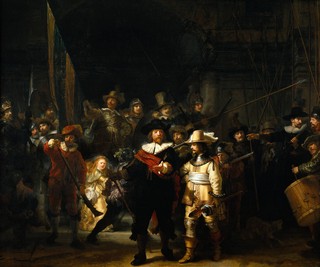

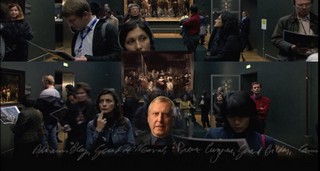
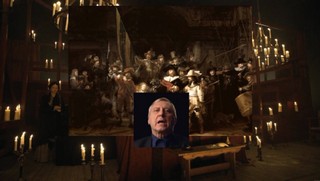
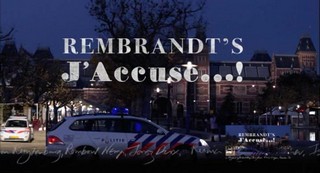
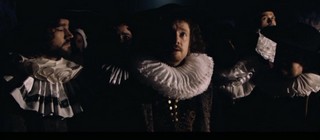

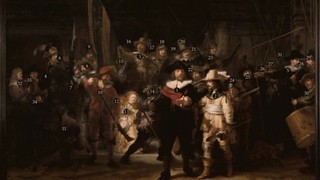
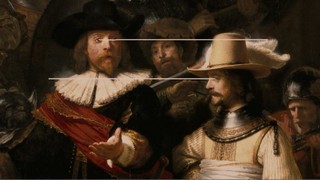
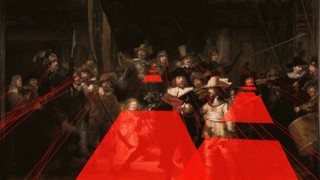
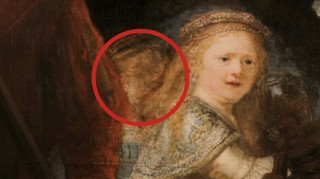
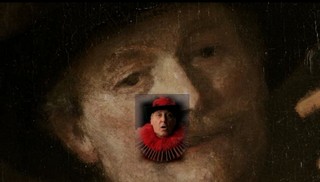
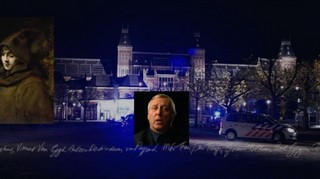
Hm. Haven’t seen these yet, but as I was reading I noticed something:
“Greenaway began his career as a painter and he contends that most people are visually illiterate, which is an interesting point. We really do live in a text-based culture. Our education system encourages textual learning over visuals, from the alphabet to vocabulary and reading skills. The proportion of time spent “reading paintings as they do text” is minute (if it happens at all). As such, our ability to analyze visual art forms like paintings is ill-informed and impoverished.”
I don’t know if I agree with this. It depends on what you mean by visually illiterate, I guess. Because I think that the majority of people are as visually literate as they are textually literate. What you seem to be comparing is the ability to read into a painting with the ability to read words, but that’s not just reading, you’re talking about analyzing and deconstructing at that point. I mean, most people can watch a movie or look at a picture and do some basic contextualizing. They pick up on things like “Oh, the guy in the black hat with the goatee is probably the bad guy. The woman that’s back-lit, wearing white is probably supposed to be innocent.” etc. In the same way that people who read a book are able to do that, too. But if you’re talking about a deep analysis of a painting like that, where you’re expected to pull it apart for clues to the back story and understand the symbolism and hidden meanings behind it, then you’re talking more about more than just reading. It’d be like handing “The Love Song of J. Alfred Prufrock” to someone… the vast majority of people won’t have a clue what most of the references are about, or what is going on. It’s not for lack of literacy, it’s for lack of training. You know how it is… there’s reading, and then there’s Reading. Most people in the United States know how to read, but that doesn’t mean that they know how to Read. Likewise with visual materials–most people know how to view a painting, they just don’t know how to View a Painting. I don’t think we’re visually illiterate morons, I just think we’re only superficially trained. Like you said, if you asked someone to, they’d still end up recognizing a lot of things. Even when people don’t have the vocabulary or training, they still pick up on things, because I think we use symbols and visual language all the time. We read expressions and body language really well, for example. Almost all of our driving rules are encoded first and foremost as symbols, not words–red=stop, green=go, yellow=caution. You don’t need “Stop” or “Yield” on the sign to know which it is–the shape of the sign tells you.
Anyway, without having seen the movie, which sounds interesting, by the way, that’s my two cents. Untrained, perhaps. Illiterate? I think not. =P
i loved this movie.
have any other documentaries about artists and their paintings like this been made? and what are the names.